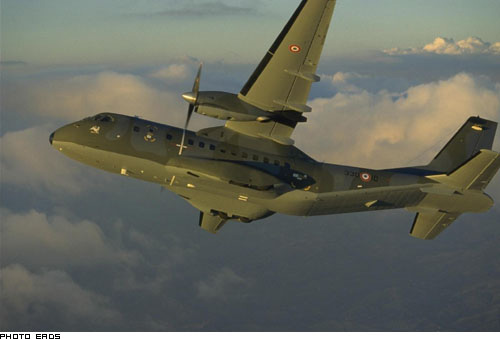CN-235
Summary
| Category | Military Transport Aircraft |
| Origin country | 🇪🇸 Spain • 🇮🇩 Indonesia |
| Manufacturer | CASA |
| First flight | 11 November 1983 |
| Year introduced | 1988 |
| Number produced | 354 units |
| Average unit price | $25 million |
Description
Development of the CN-235 formally commenced in 1980 after the formation of the Airtech International joint venture on 17 October 1979, between CASA of Spain and Indonesian manufacturer IPTN. The program was publicly unveiled at the 1981 Paris Airshow. On 11 November 1983, the first CASA-built prototype conducted its maiden flight; the first IPTN-built prototype made its first flight on 30 December 1983. The first production aircraft followed on 19 August 1986. Certification from both the Spanish and Indonesian authorities was received on 20 June 1986. On 1 March 1988, the aircraft was put into regular service. Production of each aircraft was divided, with 65% being performed by IPTN in Bandung and 35% manufactured by CASA in Getafe, regardless of the final assembly location. This workshare arrangement contributed to the competitive purchase price.
The CN-235 was designed as a twin-turboprop transport featuring a relatively wide fuselage and a rear-facing ramp, capable of accommodating up to 35 passengers or various military payloads. The main cabin facilitated a four-abreast single-aisle seating arrangement, accommodating up to 44 passengers in a dense configuration. The design emphasized versatility, enabling it to suit various operating conditions. Performance attributes pursued included good accessibility for cargo transportation and quick conversion between cargo and passenger operations. It was equipped to suit various situations and operating conditions.
The CN-235's capabilities extend to a maritime patrol version that features six hardpoints, enabling it to carry AM-39 Exocet missiles or Mk.46 torpedoes. A light gunship version, developed for the Royal Jordanian Air Force, is modified with integrated weapons pylons for AGM-114 Hellfire missiles and 70 mm rockets, a side-mounted 30 mm cannon, and a Synthetic Aperture Radar.
Amongst the first customers for the CN-235 was the French Air and Space Force, with an initial order of eight aircraft by May 1989; by 2015, the service expanded its fleet to 27 aircraft. Several sizable early orders from the Indonesian armed forces included 32 aircraft for the Indonesian Air Force and 18 for the Indonesian Navy, six of which were in a maritime surveillance configuration, by May 1989. Turkey is the largest operator of the CN-235, having placed cumulative orders for 52 transport-configured aircraft by October 1998, and ordering an additional nine CN-235 MPAs by the end of the year. During the 2000s, a modification programme equipped 19 Turkish Navy and coastguard aircraft with new maritime surveillance equipment. During the 2022 Russian invasion of Ukraine, CN-235 MPAs of the Turkish Navy patrolled the Black Sea, detecting sea mines and aiding in de-mining efforts. In December 2002, the Colombian Navy ordered two CN-235 configured for maritime patrol and anti-drug trafficking missions, while in December 2008, South Korea announced it would order four CN-235-110 MPAs to equip the South Korean Coast Guard. On behalf of the Royal Jordanian Air Force, a light gunship version of the CN-235 was introduced to service in May 2014. During 2021, an Irish CN-235 was flown to Afghanistan to assist with evacuation, and in 2022, Irish CN-235s were deployed to provide humanitarian aid to, as well as evacuate wounded civilians from, Ukraine.
Main Variants:
-
CN-235-10: The initial production version, with 15 built by each company, and powered by GE CT7-7A engines.
-
CN-235-100/110: An improved series 10 with GE CT7-9C engines in new composites nacelles; the series 100 is Spanish-built, series 110 Indonesian-built, with improved electrical, warning and environmental systems.
-
CN-235-200/220: An improved version with structural reinforcements for higher operating weights, aerodynamic improvements, reduced field length requirements and increased range; the series 200 is Spanish-built, Series 220 Indonesian-built.
-
CN-235-300: A CASA modification of the 200/220 series, featuring the Honeywell International Corp. avionics suite, improved pressurization and optional twin-nosewheel installation.
-
CN-235 MPA: A maritime patrol version with 6 hardpoints to carry AM-39 Exocet-Missiles or Mk.46-Torpedoes.
Technical specifications
| Version: AC-235 | |
|---|---|
| Crew | 2 pilots + 1 loadmaster |
| Operational range | 5,060 km (3,144 mi) |
| Maximum speed | 450 km/h (280 mph) |
| Wing area | 59.1 m² (636.1 sqft) |
| Wingspan | 25.8 m (84.7 ft) |
| Height | 8.2 m (26.8 ft) |
| Length | 21.4 m (70.2 ft) |
| Service ceiling | 9,144 m (30,000 ft) |
| Empty weight | 8,800 kg (19,401 lbs) |
| Max. takeoff weight | 16,500 kg (36,376 lbs) |
| Takeoff distance | 1,217 m (3,993 ft) |
| Powerplant | 2 x turboprops General Electric CT7-9C delivering 1305 kW each |
Current operating countries
| Country | Units | ||
|---|---|---|---|

|
Turkey | 48 | |

|
France | 27 | |

|
South Korea | 18 | |

|
Indonesia | 6 (+3) | |

|
Morocco | 6 | |

|
Mexico | 6 | |

|
United States | 5 | |

|
Colombia | 4 | |

|
Ecuador | 4 | |

|
Nigeria | 4 | |

|
Chile | 3 | |

|
Malaysia | 3 | |

|
Botswana | 2 | |

|
Mauritania | 2 | |

|
Senegal | 1 (+1) | |

|
Cameroon | 1 | |

|
Congo | 1 | |

|
Nepal | 1 | |
All operators
